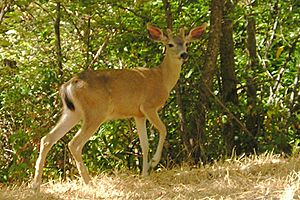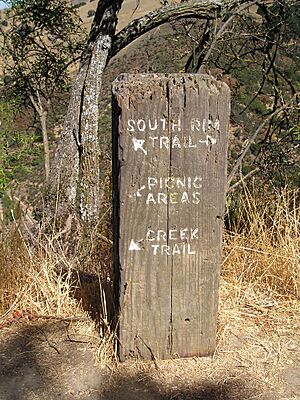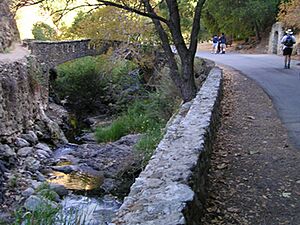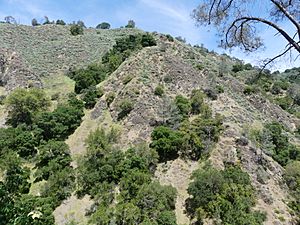Alum Rock Park facts for kids
Quick facts for kids Alum Rock Park |
|
|---|---|
View of northern Silicon Valley from South Rim Trail
|
|
| Type | Urban park |
| Location | San Jose, California |
| Area | 2.9 km2 (1.1 sq mi) |
| Created | 1872 |
| Operated by | City of San Jose |
| Status | Open except non-holiday Mondays |
Alum Rock Park is a super cool place located in San Jose, California. It's actually California's oldest city park, first opened way back in 1872! But people have been enjoying this land since 1777.
This park is huge, covering about 720 acres (that's like 545 football fields!). It sits in a beautiful valley within the Diablo Range foothills. You can explore over 13 miles (21 km) of trails here. Some trails are pretty flat and follow Penitencia Creek, while others climb steep hills for amazing views.
Inside the valley, you'll find a visitor center and a small museum. There are also fun picnic spots, playgrounds, and even sand volleyball courts. The park is known for its special mineral springs, lots of green plants, and shady woodlands. You can also play by the creek or even go group camping sometimes.
If you hike up to the ridge trails, you'll get awesome views of the whole Santa Clara Valley. Some trails in the park are part of the bigger Bay Area Ridge Trail. You can even connect to the 1,600-acre Sierra Vista Open Space Preserve from here.
Some trails are open for horseback riding and mountain bikers. Other trails are just for hikers. High school cross-country teams, like those from James Lick High School and Independence High, often train and have meets here.
Contents
Park History
How Alum Rock Park Got Its Name
This park was first called "the reservation." It got its current name around the year 1900. People thought some rocks near the entrance contained "alum," which is a type of mineral. They were mistaken, but the name stuck!
There was also a giant black rock, weighing about 2,000 tons, near the creek. People thought it might be one of the biggest meteorites in the world!
The creek running through the park is called Penitencia Creek. It used to have a different name. It's said that monks from Mission San José would meditate by its waters, which is how it got its current name.
The Old Park Railway
Imagine taking a train right into the park! In 1891, work started on a special narrow-gauge railway from downtown San Jose to the park. By 1896, about 8 miles (13 km) of track were ready.
Passengers paid 25 cents to ride to the park on street cars pulled by steam engines. The trains became electric in 1901. However, a big storm in 1911 washed out part of the track. A new, wider track was built in 1913, allowing people to reach the park from anywhere on the San Jose streetcar system. This train service to the park stopped in 1932.
Park Changes Over Time
In the 1960s, so many people visited Alum Rock Park that its facilities became too crowded. The beautiful natural scenery started to get damaged. So, in the 1970s, the park made some big changes.
They removed most of the old buildings and closed off some areas. The goal was to focus more on the park's natural beauty rather than man-made attractions. But don't worry, you can still see some of the old stone structures and parts of the railway supports today!
Dealing with Nature's Power
Alum Rock Park has faced some challenges from nature. In 1998, heavy winter storms caused many landslides. The park had to close for almost six months! One of these slides even closed the main car entrance until 2000.
On October 30, 2007, a 5.6 earthquake shook the Bay Area. Its center was very close to Alum Rock Park. This earthquake was so strong that it even made a spring that had dried up start flowing again!
In February 2017, more heavy rainstorms caused trees to fall, more landslides, and flooding. This also led to the park closing for a while.
Park Features
The Famous Springs
The valley in Alum Rock Park has many natural mineral springs. Long ago, people believed these springs were good for their health. In the late 1800s and early 1900s, the park was famous as a health resort. It advertised hot and cold springs with different minerals like sulfur, soda, and iron.
Some of these springs were even piped into bathtubs or drinking fountains. Old brochures suggested the water could help with various health issues. Back then, the park also had a huge indoor swimming pool filled with heated sulfur water! There were also private mineral baths you could rent, a restaurant, and other buildings.
Many springs were surrounded by beautiful stonework grottos, and stone bridges crossed the creek. Over time, because so many people used them, some springs dried up or became very weak.
Penitencia Creek's Sources
Penitencia Creek, which flows through the park, has two main sources. They meet at a spot called the "horse bridge" further up the creek trail. The northern fork of the creek comes from Cherry Flat Reservoir. There's a waterfall called Alum Rock Falls inside the park, but this area has been closed to visitors since the 1980s.
The southern fork, called Arroyo Aguague, starts in Grant Ranch. A few miles of this lush canyon are also within the park, but this area is also off-limits to visitors.
Youth Science Institute
The Youth Science Institute - Alum Rock Science and Nature Center opened in 1953. It's a great place to learn about natural history! The center has exhibits and a collection of live teaching animals. These include injured hawks and owls that can't be released back into the wild.
The center offers nature and science programs for schools and groups. They also have after-school science clubs and summer camps.
You can see animals that live in the park displayed at the center. There are exhibits of stuffed birds, like owls, hawks, and waterfowl. You'll also find animal bones and other remains with labels. There's a special room for live animals, each with a description. Sometimes, you might even see a pair of owls roaming freely in the room! The staff is very helpful and can give you a tour. You can also find brochures about the plants and animals in Alum Rock Park at the front desk.
Park Environment
Amazing Plants
The steep sides of the valley are home to many different native California plants. On the sunny, south-facing slopes, you'll mostly see grasses, poison oak, sagebrush, and some live oak trees. The warm sun on the sagebrush creates a unique smell in the air.
The shadier, north-facing slopes have more trees. These include coast live oak, California bay laurel, madrone, and California buckeye. Down on the valley floor, where it's moist along Penitencia Creek, you'll find bigleaf maple, white alder, and western sycamore. These trees provide lots of shade for the many ferns.
Some common native plants in the park are California fuchsia, California wild rose, black sage, hummingbird sage, and blackberry. However, some plants that aren't native, like star thistle and cape ivy, can cause problems for the park's natural environment.
Wildlife You Might See

Many different birds live in the park. You might spot a red-tailed hawk, red-shouldered hawk, Cooper's hawk, or even a turkey vulture soaring overhead. Other birds include wild turkeys, mallards, great blue herons, Steller's jays, and California quail.
Owls native to the park include the western screech owl, barn owl, great horned owl, and northern pygmy owl. The northern pygmy owl is special because it's active during the day, unlike most owls!
Larger animals you might see are black-tailed deer, gray foxes, bobcats, and sometimes even a mountain lion. Smaller creatures include darkling beetles, tarantulas, black widow spiders, and Pacific tree frogs. Two types of lizards, the southern alligator lizard and western fence lizard, also live here. In Penitencia Creek, you might find native fish like the California roach.
Be aware that rattlesnakes (specifically the northern Pacific rattlesnake) are active in the summer. They sometimes rest in the plants along the trails. Other harmless snakes you might see include the California kingsnake, California mountain kingsnake, Rosy boa, Pacific gopher snake, and Western_yellow-bellied_racer.
In the wooded areas, you might find different kinds of salamanders, like the Yellow-Eyed Ensatina, California Slender Salamanders, and Arboreal Salamanders.
See Also
- San Jose, California
- Parks and Public Spaces of San Jose
- San Jose and Silicon Valley attractions
Images for kids







